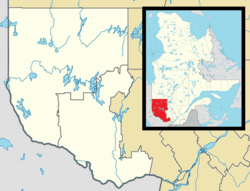Lac-Simon Anishnabe Nation facts for kids
Quick facts for kids
Lac-Simon
|
|
|---|---|
 |
|

Location within La Vallée-de-l'Or RCM
|
|
| Country | Canada |
| Province | Quebec |
| Region | Abitibi-Témiscamingue |
| Area | |
| • Land | 3.14 km2 (1.21 sq mi) |
| Population
(2021)
|
|
| • Total | 1,285 |
| Time zone | UTC−05:00 (EST) |
| • Summer (DST) | UTC−04:00 (EDT) |
Lac-Simon is a special place in Quebec, Canada. It is an Indigenous community and a beautiful lake. The community is also known as Simosagigan. It is home to First Nations people, specifically the Algonquin people. Lac-Simon is located about 32 kilometers (20 miles) south-east of Val-d'Or.
Contents
About Lac-Simon
The Lac-Simon reserve covers about 3.14 square kilometers (1.2 square miles) of land. In 2021, about 1,285 people lived there. The community is governed by the Nation anishnabe du Lac Simon.
The Lake Itself
The lake is quite large, stretching about 15 miles long and 2 miles wide. It has a big island that even has a smaller pond inside it! There are also many small islands on the lake. Some of these islands are big enough for people to go camping on. Around the lake, you can find many cottages and summer houses.
History of the Community
The community of Lac-Simon began to form around 1910. A missionary named Étienne Blanchin and the Hudson's Bay Company encouraged Algonquin people from another area called Kitcisakik (Grand-Lac-Victoria) to settle here. Later, other Algonquin families were invited to move to Lac-Simon as well.
Interesting Facts
Plane Discovery
In the 1950s, a small plane called a Republic RC-3 Seabee crashed into the lake. It had four people on board and sank into very deep water. For many years, no one knew exactly where it was. Then, in 2007, the aircraft was discovered! It was found about 150 feet (46 meters) deep in the lake.
Wildlife Return
In the mid-1980s, something exciting happened in the area. Deer, which had been rare, started to return to the forests around Lac-Simon. This event was so interesting that it was featured on a TV show called Lorne Greene's New Wilderness.



